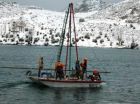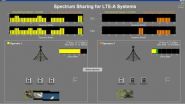(Press-News.org) NASA satellites have watched as wind shear has torn Cyclone Iggy apart over the last day. NASA infrared satellite imagery showed that Iggy's strongest thunderstorms have been pushed away from the storm's center and visible imagery shows the storm is being stretched out. Iggy is weakening and heading for a landfall between Geraldton and Perth.
When NASA's Aqua satellite passed over Tropical Cyclone Iggy on Feb. 1 at 1805 UTC (1:05 p.m. EST), the Atmospheric Infrared Sounder (AIRS) instrument aboard captured an infrared look at the cyclone. AIRS data showed that the strongest thunderstorms (with the coldest cloud top temperatures) had been pushed to the southeast of Iggy's center. That convection was pushed by vertical wind shear from the northwest. Once convection is pushed away from a tropical cyclone's center, the storm begins to fall apart. Tropical cyclones must be stacked in the atmosphere like a haystack. If the middle (convection in this case) gets pushed out, then the storm collapses.
The Moderate Resolution Imaging Spectroradiometer (MODIS) instrument aboard NASA's Aqua satellite captured a true color image of Iggy when it passed overhead on Feb. 2, 2012 at 0615 UTC (1:15 a.m. EST). The MODIS image clearly shows how the wind shear is affecting the tropical depression because Iggy appears elongated from northwest to southeast, which is the direction of the wind shear.
The Australian Bureau of Meteorology (ABM) issued severe weather warnings for residents from Kalbarri to Morawa, and from Morawa to Wongan Hills; and Wongan to Narrogin and Harvey. The ABM website noted that the warning includes people in, near or between the following towns: Geraldton, Jurien Bay, Perth, Mandurah, York and Narrogin. Those areas can expect thunderstorms with heavy rainfall, and gusty winds as Iggy continues moving east. Flash flooding is also a possibility from the heavy rainfall.
On February 2, 2012, Tropical Depression Iggy had maximum sustained winds near 30 knots (~35 mph/~56 kph). It was located about 170 nautical miles (~196 miles/~315 km) northwest of Perth, Western Australia, and its center was near 29.9 South latitude and 114.2 East longitude. Iggy was moving to the east at 14 knots (16 mph/~26 kph) and is expected to continue in that direction making landfall before 0300 UTC on February 3, 2012 (or before 10 p.m. EST, Feb. 3). Iggy is expected to quickly weaken to a remnant low as it moves further inland in Western Australia.
INFORMATION:
NASA satellites see wind shear battering Tropical Depression Iggy
2012-02-06
ELSE PRESS RELEASES FROM THIS DATE:
A battle of the vampires, 20 million years ago?
2012-02-06
CORVALLIS, Ore. – They are tiny, ugly, disease-carrying little blood-suckers that most people have never seen or heard of, but a new discovery in a one-of-a-kind fossil shows that "bat flies" have been doing their noxious business with bats for at least 20 million years.
For bats, that's a long time to deal with a parasite doing its best vampire impression. Maybe it is nature's revenge on the vampire bat, an aggressive blood consumer in its own right that will feed on anything from sheep to dogs and humans.
The find was made by researchers from Oregon State University ...
Breastfeeding and lung function at school age: Does maternal asthma modify the effect?
2012-02-06
Breastfeeding is associated with improved lung function at school age, particularly in children of asthmatic mothers, according to a new study from researchers in Switzerland and the UK.
"In our cohort of school age children, breastfeeding was associated with modest improvement in forced mid-expiratory flow (FEF50) in our whole group and with improvements in forced vital capacity (FVC) and forced expiratory volume at 1 second (FEV1) only in the children of asthmatic mothers," said Claudia E. Kuehni, MD, MSc, professor at the Institute of Social and Preventive Medicine ...
Classic portrait of a barred spiral galaxy
2012-02-06
Most spiral galaxies in the Universe have a bar structure in their centre, and Hubble's image of NGC 1073 offers a particularly clear view of one of these. Galaxies' star-filled bars are thought to emerge as gravitational density waves funnel gas toward the galactic centre, supplying the material to create new stars. The transport of gas can also feed the supermassive black holes that lurk in the centres of almost every galaxy.
Some astronomers have suggested that the formation of a central bar-like structure might signal a spiral galaxy's passage from intense star-formation ...
New procedure repairs severed nerves in minutes, restoring limb use in days or weeks
2012-02-06
American scientists believe a new procedure to repair severed nerves could result in patients recovering in days or weeks, rather than months or years. The team used a cellular mechanism similar to that used by many invertebrates to repair damage to nerve axons. Their results are published today in the Journal of Neuroscience Research.
"We have developed a procedure which can repair severed nerves within minutes so that the behavior they control can be partially restored within days and often largely restored within two to four weeks," said Professor George Bittner from ...
New technique dissolves blood clots in the brain and lowers risk of brain damage after stroke
2012-02-06
Johns Hopkins neurologists report success with a new means of getting rid of potentially lethal blood clots in the brain safely without cutting through easily damaged brain tissue or removing large pieces of skull. The minimally invasive treatment, they report, increased the number of patients with intracerebral hemorrhage (ICH) who could function independently by 10 to 15 percent six months following the procedure.
At the International Stroke Conference taking place January 31 through February 2 in New Orleans, the researchers will present their findings from 93 patients, ...
New technology to tackle treatment-resistant cancers
2012-02-06
Free-flowing cancer cells have been mapped with unprecedented accuracy in the bloodstream of patients with prostate, breast and pancreatic cancer, using a brand new approach, in an attempt to assess and control the disease as it spreads in real time through the body, and solve the problem of predicting response and resistance to therapies.
In comparison to a previous generation of systems, the researchers state their test showed a significantly greater number of high-definition circulating tumour cells (HD-CTCs), in a higher proportion of patients, by using a computing-intensive ...
NYU Courant researchers weigh methods to more accurately measure genome sequencing
2012-02-06
Lost in the euphoria of the 2003 announcement that the human genome had been sequenced was a fundamental question: how can we be sure that an individual's genome has been read correctly?
While the first full, individual genome was sequenced a decade ago, given the vast genetic variation across the world's seven billion people, not to mention the differences in makeup even among close relatives, the question of accurate sequencing for individuals has continued to vex researchers.
With companies now projecting they can sequence a genome for a $1,000, down from $25,000 ...
Parasites or not? Transposable elements in fruit flies
2012-02-06
Nearly all organisms contain pieces of DNA that do not really belong to them. These "transposable elements", so called because they are capable of moving around within and between genomes, generally represent a drain on the host's resources and in certain cases may lead directly to disease, e.g. when they insert themselves within an essential host gene. The factors that govern the spread of transposable elements within a population are broadly understood but many of the finer points remain unclear. New work at the University of Veterinary Medicine, Vienna (Vetmeduni ...
Sediments from the Enol lake reveal more than 13,500 years of environmental history
2012-02-06
A team of Spanish researchers have used different geological samples, extracted from the Enol lake in Asturias, to show that the Holocene, a period that started 11,600 years ago, did not have a climate as stable as was believed.
The Holocene period, which includes the last 11,600 years of our history, has always been described as a stable period in terms of climatic conditions, especially when compared to the abrupt changes that occurred in the last ice age, which ended around 10,000 years ago, giving way to the Holocene.
A study carried out by researchers from the Pyrenean ...
Jointly utilizing LTE networks
2012-02-06
Smartphones and tablets are some of the big sellers of the past year. Mobile Internet usage has increased rapidly with the sales success: according to a study of the industry association VATM, in 2011 the average data volume per mobile Internet user increased by 82 percent in Germany. In contrast to its predecessor UMTS, with the new LTE mobile radio standard, the clearly higher data rates and the shorter signal transmission times, providers want to cover the expected traffic. That is why the expansion of the LTE network is being pursued aggressively. Providers are setting ...



